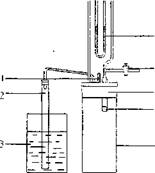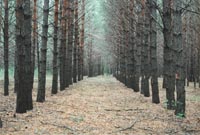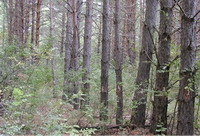|
"Хвойные бореальной зоны" 2004г. с.
143-146
THE PROCESS OF DERESINNING AND DRYING OF MASSON'S PINE
Du Guoxing, Dong Hiujun, Cai Jiabin
Nanjing Forestry University Wood Drying Lab. Nanjing, China
Masson's Pine is a large resource of softwood in south-China. Its hardness and mechanical properties are middling. But there are lots of resin in Masson's Pine. The rosin acid will permeate from the lumber. Because of the resin, the utilization of Masson's Pine is limited. In order to enhance its utilization sufficiently, deresinning and drying of Masson's Pine are researched in this paper.
The results are as follows:
- It is feasible to eliminate the resin by the alkaline liquor of NaHC03.
- The main factors inflecting the effect of deresinning are the concentration of the liquor, the temperature of the liquor, the time of the processing and the proportion of the volume of water to that of the lumber.
- After deresining, the permeability of water is improved, and the time of the drying process is decreased.
- The main mechanical properties of Masson's Pine lumber are not changed.
INTRODUCTION
More than 10 fast-growing species of trees grow in China. The most is Maason's Pine. Especially in south-China, It is over 50 percent of all species. Masson's Pine is a medium density, medium strength softwood. It has light color and beautiful grain after being sawed. There are lots of resin in Masson's Pine. The fluid turps, one main ingredient of the resin, is volatile. The resin acid will contaminate the timber if permeate from the interior to the surface, and it will become difficult to sand. So Masson's Pine is limited in furniture and decoration industy. In order to decrease the absence crisis of wood in China and enhance Masson's Pine's usefulness, many Chinese scholars have researched the deresinning and drying technology of Masson's Pine.
The reaction between resin acid and alkaline regent will produce dissoluble organic salt because that there is
-COOH in the molecular construction of resin acid. The reactive equation is as follows: C10H2oCOOH+OH"=CioH20COO"+H20
MATERIAL AND METHODS
The timbers of Masson's Pines were obtained from province Fujian in south-China with average thickness of 5cm, initial MC averaged 26.7 percent. They were immersed in water to be prevented from blue stain. The alkaline reagent NaHC03 was used in the study.
The timbers were sawn to 200mm length, 100mm width and 50mm thickness boards which would be used as the samples to calculate the deresining rates. The samples which would be used to calculate the percentage of resin were produced, matched the deresinning samples. The former would be boiled in alkaline liquor to deresin. The penetrate rate in radial and tangential directions can be ignored, compared with that in longitudinal direction. In order to
ensure the accuracy of the experiment, anti-high-temperature, waterproof silicone sealant was used, covering the end of samples. The samples covered with sealant must be exposed to the air for 24 hours so that the sealant on the end dried completely.
The samples to calculate the percentage of resin were ground into 40-60 meshes powder, which would be wrapped with filter paper and cotton line. Writing down the initial weights, then put them in the oven at the unchanging temperature of 100±2°C until the errors of the weight is 0.00 lg at most at intervals of one hour. The last results are the oven weights called G0. Then, the packages of wood powder were set in the extracting apparatus(FIGURE 1) to be extracted for 10 hours at the unchanging temperature of 30-40°C with the dissolvent of ether. After that, drying the packages in the oven to get the oven weights called Gj. The percentage of the risen of the samples will be calculated by substituting the experimental date into the following formula.
Table 1 Technical factor and value
Factor |
Value |
Concentr ation of alkaline
(g/cm3) |
Tempera ture (°C) |
Time (h) |
Proportion of volume |
1 1 |
0.2 |
60 |
8 |
2 |
2 |
0.3 |
80 |
10 |
3 |
3 |
0.5 |
100 |
12 |
4 |
N(%)=G0-G1/G1?100% (1)
Where:
N = the percentage of the risen (%)
G0= THE OVEN WEIGHT OF THE SAMPLE BEFORE BEING EXTRACTED (G)
Gi = the oven weight of the sample after being extracted (g)
The deresinning samples were boiled in alkaline liquor with various concentration, different temperature, time and the volume proportion of water to wood. Table 1 shows the values of those above factors. The schedule and the results of the experiment are showed in the table 2 .
After being deresinned, each board sample was ground into wood powder, step by step, the average and gradient resin content can be calculated by the Fq.(l).
The deresinning rate was calculated by the
following formula:
X(%) = No-N1/N1?100%
Where:
X = deresinning rate (%)
N0 = percentage of resin before being extracted
(%)
Ni = percentage of resin after being extracted
(%)
The best schedule can be obtained by calculating the data shown in table 2. With the best schedule, some samples were deresinned. After that, they were split into 5 layers in the thickness direction to obtain the gradient resin content and the deresinning rate of each player. The results showed in table
In order to estimate the result of the experiment, all the permeability of samples deresinned and underesinned had been researched. The appliance to research the permeability is shown as the Fig.3.
Exit of condensing water Entry of condensing watei
FIGURE 1. Extracting appliance
1, cOl1densing pipe
2, immersil1g tube
3, package of sample
4, dissolving bottle
The ? 15тm, 15тm length cylinder samples were made from the board deresinned with the best schedule. All the samples were classified into radial and tangential ones, sapwood and heartwood. Each style was classified according to the moisture content too. Because the environment temperature would affect the viscosity of water, it must be recorded when test the permeability of the samples.
The other directions should be sealed to ensure the accuracy of the experiment and the air-tightness of the entire appliance should be taken more attention.
At last, the drying technology was researched after the timber being deresinned. The best drying schedule is showed in table 4.
RESULTS AND DICUSSION
The data showed in table 2 prove that the concentration of alkaline of 0.5%, the temperature of 80°C, the time of 8 hours and the volume proportion of water to wood of 4 are the best schedule. The effect of each factor illustrated as the Fig.2 (a-d). It is obvious that the most important factor affecting deresinning is temperature, second the time, third the concentration of alkaline and last the volume proportion of water to Masson's Pine.
We can draw conclusion from the Fig.2 (a) that the deresinning rate increases with the adding of concentration of alkaline.
With the increasing of the concentration of alkaline, the chemical reaction between the resin-acid and alkaline will become more thorough, the resin will be extracted more efficiently.
On the other hand, the alkaline liquor will make the physical structure of Masson's Pine swell, as a result, the bending strength will decreases as the concentration of alkaline added.
The date illustrated graphically in Fig 2(a) show that the efficiency-concentration curve rises first and drops behind the highest point, the best efficiency is at the concentration of 0.5%. The efficiency-temperature curve in Fig 2(b) showes that the curve will drop with the increasing of temperature. The high temperature can improve the activity of alkaline molecular, so it is easy for the alkaline molecular to penetrate into the interior of the samples. OF course, the temperature will accelerate the chemical reaction. As a result, the efficiency of deresinning will increase. But to the bending strength, the higher the temperature, the more easy that the fiber to be dissolved in alkaline liquor, so the bending strength will decrease, leading the entire efficiency cure drop with the rising of temperature.
Table 2 - The experiment schedule and result
Factors |
No.of. experiments |
С |
T |
H |
F |
Deresinning rate(%) |
Bending strength rate(%) |
efficiency (%) |
1 |
1 |
1 |
3 |
2 |
84.07 |
94.28 |
89.18 |
2 |
2 |
1 |
1 |
1 |
92.14 |
93.64 |
92.89 |
3 |
3 |
1 |
2 |
3 |
96.94 |
88.32 |
92.63 |
4 |
1 |
2 |
2 |
1 |
93.36 |
90.95 |
92.16 |
5 |
2 |
2 |
3 |
3 |
98.40 |
83.58 |
90.99 |
6 |
3 |
2 |
1 |
2 |
94.31 |
84.06 |
89.19 |
7 |
I |
3 |
1 |
3 |
90.71 |
76.52 |
83.62 |
8 |
2 |
3 |
2 |
2 |
97.47 |
76.37 |
86.92 |
9 |
3 |
3 |
3 |
1 |
92.21 |
67.52 |
79.87 |
Kl |
265.0 |
274.7 |
265.7 |
264.9 |
|
K2 |
270.8 |
272.3 |
271.7 |
265.3 |
КЗ |
261.7 |
250.4 |
260.0 |
267.2 |
Kl |
88.33 |
91.57 |
88.57 |
88.30 |
|
K2 |
90.27 |
90.77 |
90.57 |
88.43 |
КЗ |
87.23 |
83.47 |
86.67 |
89.07 |
R |
3.04 |
7.30 |
3.90 |
0.77 |
|
Where: С—concentration of alkaline liquor ; T—temperature ; H—time ; F—proportion of volume
Table 3 The percentage of resin and the deresinning rate
Factors |
No. of board |
The pen before с |
rentage of resin eresinning (%) |
The percentage of resin after deresinning (%) |
Deresinning rate (%) |
Surface layer (%) |
Middle layer (%) |
Core layer (%) |
Surface layer (%) |
Middle layer (%) |
Core layer (%) |
Surface layer (%) |
Middle layer (%) |
Core layer
(%) |
1 |
2.70 |
3.13 |
4.01 |
0.18 |
0.42 |
0.85 |
93.34 |
86.59 |
78.81 |
2 |
5.76 |
6.11 |
7.89 |
0.25 |
0.53 |
0.86 |
95.66 |
91.33 |
89.23 |
3 |
2.63 |
3.24 |
4.93 |
0.03 |
0.16 |
0.18 |
98.86 |
95.04 |
96.35 |
4 |
2.50 |
3.34 |
4.78 |
0.13 |
0.21 |
0.32 |
*94.80 |
93.72 |
93.31 |
5 |
3.74 |
4.06 |
5.53 |
0.06 |
0.11 |
0.19 |
98.28 |
97.91 |
96.65 |
6 |
3.21 |
4.21 |
5.91 |
0.10 |
0.31 |
0.43 |
96.89 |
92.63 |
92.24 |
7 |
3.05 |
4.37 |
5.69 |
0.26 |
0.44 |
0.65 |
91.48 |
89.94 |
88.57 |
8 |
2.51 |
3.48 |
4.53 |
0.01 |
0.07 |
0.19 |
99.61 |
97.99 |
95.91 |
9 |
6.54 |
8.32 |
10.1 |
0.14 |
0.56 |
1.01 |
97.86 |
93.27 |
90.03 |
Table 4. Drying schedule
Stage |
Moisture content (%) |
Dry-bulb temperature
(°C) |
Wet-bulb temperature
(°C) |
Relativity humidity (%) |
Pre-steaming |
|
101 |
99 |
|
Drying |
>40 |
110 |
97 |
64 |
|
40-25 |
113 |
97 |
57 |
Steaming |
25 |
102 |
100 |
|
Drying |
25-20 |
117 |
98 |
50 |
|
20-15 |
120 |
100 |
50 |
|
(15 |
125 |
100 |
40 |

|
FIGURE.3 Equipment of permeability 1Ч exhausting valve 2 ч glass pipe 3S water 44 mercury 54 vacuum valve 64 plastic pipe 74 wood sample 84 glass tube with flat bottom |
Table 5. Drying quality
No. |
Initial MC (%) |
Final MC (%) |
Drying defects |
1-1 |
73 |
14 |
No surface checks, Honeycomb, End checks and splits, Warp. Somewhat yellow, Little resin leaked. |
1-2 |
68 |
14.5 |
Same as above |
1-3 |
67 |
13 |
One surface check long about 1cm, No end check sand splits, No warp, Somewhat yellow. |
The larger property of volume and the more alkaline molecular, the more thorough the reaction between alkaline and resin-acid as illustrated in Fig.2 (c). The efficiency-time curve showed in Fig2 (d) proves that the efficiency is affected by time too. As the time becomes more long, the chemical reaction becomes more
thorough, but the bending-strength will become more weaker. The efficiency will be the best at the time of 8 hours.
From table 3, we could drawn the conclusions that: (1) after deresinning, the resin contents of all the layers were more less than underesinned; (2) the deresinning rate was
higher; (3) the deresinning rate of the surface layer was higher than that of the heart layer.
The data obtained from the experiment prove that the permeability coefficient of the samples had been deresinned are higher than that not had been treated and the permeability in radial direction improved more strongly than that in tangential direction after deresinning. So drying time was reduced. The drying schedule is shown as follow table 4. About 40 hours was spent to dry 50mm thickness Masson's Pine lumber from initial moisture content of 70% to final moisture content of 14%. The drying time is shorter than that to dry the underesinned lumber. The drying quality showed in table 5 is fine.
It had been proved that the mechanical properties have no more change compared with that no deresinned.
CONCLUSION
- It is feasible to deresin Masson's Pine by the alkaline reagent NaHC03. The best parameters are as follows: the time is 12 hours; the concentration of alkaline liquor is 0.5%; the temperature is 90°C; the volume proportion is 4.
- The deresinning rate is more than 90%;
- The permeability in radial direction is greater than that in tangential direction and all of them improve after deresinning.
- The high temperature is feasible to dry Masson's Pine deresinned and the drying quality is fine.
|




